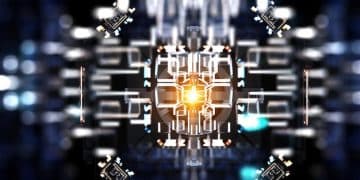Deepfake Detection: New AI Tools Hit 99% Accuracy?

Deepfake detection is rapidly evolving with new AI tools claiming up to 99% accuracy in identifying synthetic media, though challenges remain in real-world application and adversarial attacks.
The rise of deepfakes poses a significant threat to trust and credibility in the digital age. Deepfake detection: Can new AI tools identify synthetic media with 99% accuracy? This question is driving innovation and intense research in the field of artificial intelligence. Let’s explore the current state of deepfake detection technology and whether these new tools truly live up to the accuracy claims.
Understanding the Deepfake Threat
Deepfakes, synthetic media created using AI, are becoming increasingly sophisticated. They can be used for malicious purposes, including spreading misinformation, manipulating public opinion, and damaging reputations. The ease with which deepfakes can now be created and disseminated poses a serious challenge to individuals, organizations, and society as a whole.
How Deepfakes are Made
Typically, deepfakes are created using deep learning techniques, particularly generative adversarial networks (GANs). These networks consist of two parts: a generator that creates synthetic content and a discriminator that tries to distinguish between real and fake content. Through a process of continuous improvement, the generator learns to create increasingly realistic deepfakes.
The Impact of Deepfakes
The potential impact of deepfakes is far-reaching. They can erode trust in media, sow political discord, and even be used for financial fraud. The consequences of a successful deepfake campaign can be devastating, making accurate and reliable detection methods essential.
- Erosion of Trust: Deepfakes can make it difficult to distinguish between real and fake content.
- Political Manipulation: They can be used to spread false information and influence elections.
- Reputational Damage: Individuals and organizations can be targeted with malicious deepfakes.
- Financial Fraud: Deepfakes can be used to impersonate individuals for financial gain.
As deepfake technology advances, the need for robust detection methods becomes increasingly critical. The challenge lies in staying ahead of the curve, as deepfake creators constantly refine their techniques to evade detection.

Current Deepfake Detection Technologies
Researchers and developers are working tirelessly to create effective deepfake detection tools. These technologies employ a variety of techniques to analyze and identify synthetic media. From analyzing facial features to examining video inconsistencies, the goal is to reliably distinguish between real and fake content.
AI-Powered Detection Methods
Many deepfake detection methods rely on artificial intelligence, particularly machine learning. These models are trained on vast datasets of real and fake images and videos, learning to identify patterns and anomalies that indicate manipulation.
Analyzing Facial Features
One common approach is to analyze facial features, such as eye blinking, lip movements, and facial expressions. Deepfakes often exhibit subtle inconsistencies in these areas, which can be detected by AI algorithms. However, as deepfake technology improves, these inconsistencies become harder to spot.
Examining Video Inconsistencies
Another technique involves examining video inconsistencies, such as unnatural lighting, blurring, or artifacts. Deepfakes may contain subtle flaws in these areas, which can be detected through careful analysis. However, advanced deepfakes are designed to minimize these inconsistencies, making detection more challenging.
Current deepfake detection technologies are showing promise, but they are not foolproof. They are constantly being tested and refined to improve their accuracy and reliability. Achieving a 99% accuracy rate in real-world scenarios remains a significant challenge.
Claims of 99% Accuracy: Are They Real?
The claim that new AI tools can identify synthetic media with 99% accuracy is certainly attention-grabbing. However, it’s important to examine these claims with a critical eye. While some tools may achieve high accuracy rates in controlled environments, real-world performance can be significantly different.
Controlled vs. Real-World Environments
Many deepfake detection tools are tested in controlled environments with specific datasets. These datasets may not fully represent the diversity and complexity of real-world deepfakes. As a result, accuracy rates can be inflated.
The Importance of Diverse Datasets
To achieve reliable deepfake detection, it’s essential to train AI models on diverse datasets that include a wide range of deepfake techniques, image qualities, and scenarios. Models trained on limited datasets may perform poorly when faced with novel deepfakes.
Addressing Adversarial Attacks
Deepfake detection tools must also be robust against adversarial attacks. These are deliberate attempts to fool the detection system by subtly modifying deepfakes to evade detection. AI models must be trained to recognize and resist these attacks.
- Controlled Environments: Testing in controlled environments can lead to inflated accuracy rates.
- Diverse Datasets: Training on diverse datasets is essential for real-world performance.
- Adversarial Attacks: Deepfake detection tools must be robust against adversarial attacks.
While claims of 99% accuracy may be technically true in certain contexts, it’s important to understand the limitations. Achieving this level of accuracy in real-world scenarios requires ongoing research, development, and testing.

Challenges in Deepfake Detection
Deepfake detection faces numerous challenges, ranging from the rapid evolution of deepfake technology to the need for robust and reliable detection methods. Overcoming these challenges requires a multi-faceted approach that combines technical innovation, ethical considerations, and public awareness.
The Evolving Deepfake Landscape
Deepfake technology is constantly evolving, with new techniques and methods emerging all the time. This makes it difficult for detection tools to keep up. Detection methods must be continuously updated and refined to stay ahead of the curve.
Lack of Standardized Datasets
The lack of standardized datasets for deepfake detection is another significant challenge. Researchers and developers often rely on proprietary datasets, making it difficult to compare and evaluate different detection methods.
Ethical Considerations
Deepfake detection also raises ethical considerations. Overly aggressive detection methods could potentially lead to false positives, wrongly accusing individuals of creating or sharing deepfakes. Striking a balance between accuracy and fairness is essential.
Addressing these challenges requires collaboration between researchers, developers, policymakers, and the public. By working together, we can develop effective deepfake detection methods that protect individuals and society from the harmful effects of synthetic media.
The Role of AI in Combating Deepfakes
Artificial intelligence plays a crucial role in both creating and combating deepfakes. AI-powered detection methods are essential for identifying synthetic media, but they must also be used responsibly and ethically.
AI as a Double-Edged Sword
AI can be used to create incredibly realistic deepfakes, but it can also be used to detect them. This creates a constant arms race between deepfake creators and detection tool developers. Staying ahead requires ongoing innovation and research.
The Importance of Explainable AI
Explainable AI (XAI) is becoming increasingly important in deepfake detection. XAI methods provide insights into how AI models make decisions, allowing researchers and users to understand why a particular piece of media was flagged as a deepfake. This can help build trust in the detection process.
Developing Robust and Reliable AI Models
Developing robust and reliable AI models for deepfake detection requires large, diverse datasets, advanced training techniques, and ongoing testing. These models must be able to handle a wide range of deepfake techniques and be resilient against adversarial attacks.
AI is a powerful tool in the fight against deepfakes, but it must be used responsibly and ethically. By focusing on explainability, robustness, and reliability, we can harness the power of AI to protect individuals and society from the harmful effects of synthetic media.
Future Trends in Deepfake Detection
The field of deepfake detection is constantly evolving, with new technologies and methods emerging all the time. Looking ahead, several key trends are likely to shape the future of deepfake detection.
Advancements in AI and Machine Learning
Advancements in AI and machine learning will continue to drive innovation in deepfake detection. New algorithms and techniques will enable more accurate and reliable detection methods. This includes the development of more sophisticated neural networks and the use of unsupervised learning techniques.
Blockchain-Based Verification
Blockchain technology could play a role in verifying the authenticity of media content. By creating a tamper-proof record of media creation and distribution, blockchain can help ensure that content is genuine and has not been manipulated.
Collaboration and Information Sharing
Collaboration and information sharing between researchers, developers, and policymakers will be essential for combating deepfakes. By sharing datasets, algorithms, and best practices, we can collectively improve deepfake detection capabilities.
- AI Advancements: New AI algorithms will improve detection accuracy.
- Blockchain Verification: Blockchain can help verify media authenticity.
- Collaboration: Collaboration is essential for sharing knowledge and resources.
The future of deepfake detection will be shaped by ongoing innovation, collaboration, and ethical considerations. By embracing these trends, we can develop effective methods for protecting individuals and society from the harmful effects of synthetic media.
| Key Point | Brief Description |
|---|---|
| 🛡️ Deepfake Threat | Deepfakes can erode trust, manipulate politics, and damage reputations. |
| 🤖 Detection Technologies | AI analyzes facial features and video inconsistencies to identify deepfakes. |
| 🎯 Accuracy Claims | 99% accuracy is achievable in controlled settings, but real-world performance varies. |
| 🚀 Future Trends | AI advancements, blockchain verification, and collaboration will shape deepfake detection. |
FAQ
▼
Deepfakes are synthetic media, typically videos or images, where a person’s likeness has been digitally altered or replaced with someone else’s, often using artificial intelligence.
▼
Accuracy varies, with some tools claiming up to 99% in controlled settings. However, real-world accuracy can be lower due to diverse deepfake techniques and adversarial attacks.
▼
Deepfake detection often employs AI and machine learning to analyze facial features, video inconsistencies, and audio patterns to identify synthetic media.
▼
Challenges include the rapid evolution of deepfake techniques, the lack of standardized datasets, and the need to address adversarial attacks designed to fool detection systems.
▼
Stay informed about deepfake technology, critically evaluate media content, and support the development of robust detection tools. Be skeptical of sensational or unbelievable content.
Conclusion
While deepfake detection: Can new AI tools identify synthetic media with 99% accuracy? Though this level of accuracy is theoretically possible, real-world challenges and the evolving nature of deepfake technology mean that ongoing research and vigilance are crucial. By staying informed and supporting the development of robust detection methods, we can mitigate the risks posed by deepfakes and protect the integrity of information in the digital age.





